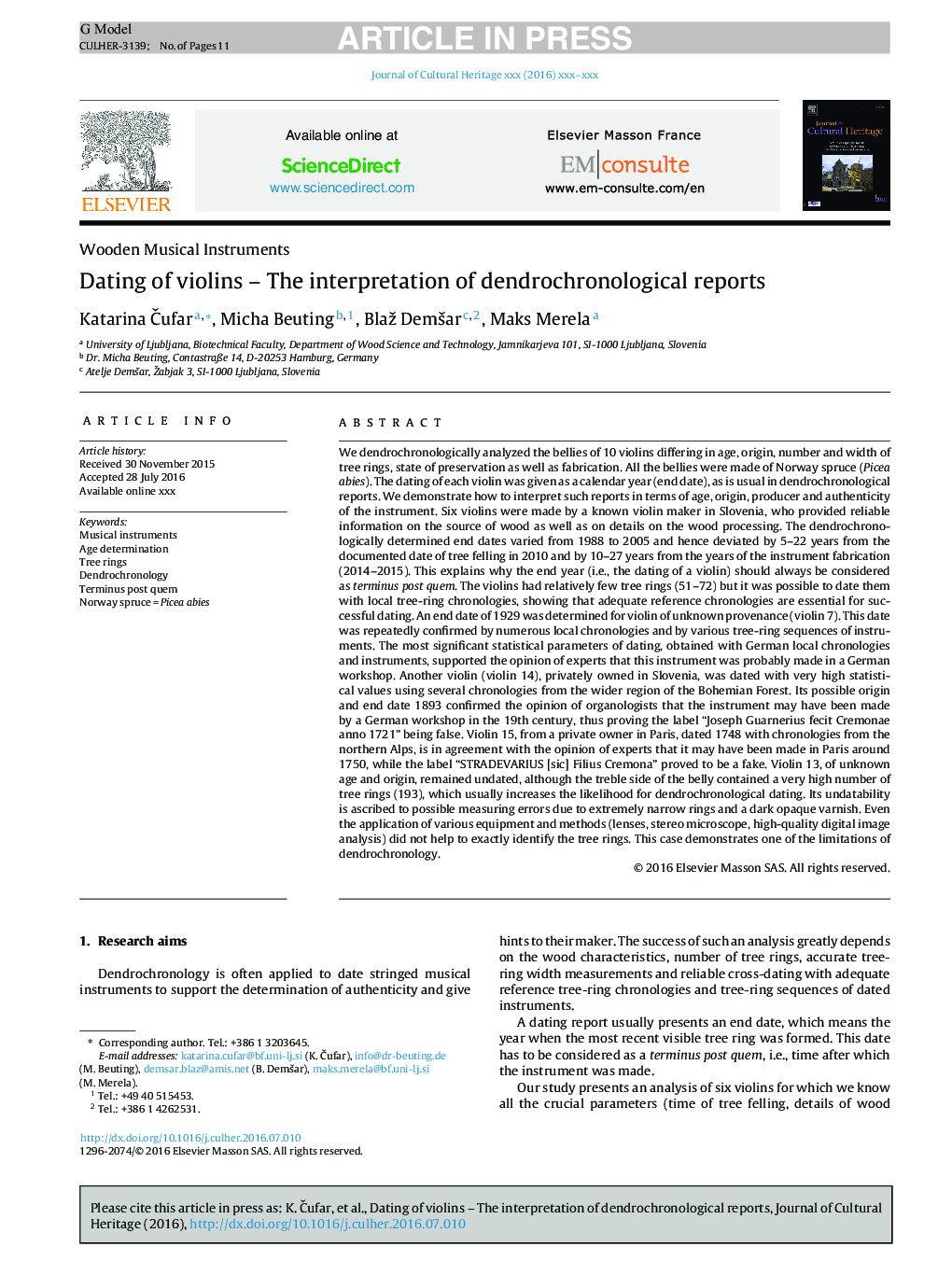| کد مقاله | کد نشریه | سال انتشار | مقاله انگلیسی | نسخه تمام متن |
|---|---|---|---|---|
| 5112721 | 1377894 | 2017 | 11 صفحه PDF | دانلود رایگان |
عنوان انگلیسی مقاله ISI
Dating of violins - The interpretation of dendrochronological reports
ترجمه فارسی عنوان
آشنایی از ویولون - تفسیر گزارش های دندرونگنولوژیک
دانلود مقاله + سفارش ترجمه
دانلود مقاله ISI انگلیسی
رایگان برای ایرانیان
کلمات کلیدی
موضوعات مرتبط
مهندسی و علوم پایه
شیمی
شیمی تئوریک و عملی
چکیده انگلیسی
We dendrochronologically analyzed the bellies of 10 violins differing in age, origin, number and width of tree rings, state of preservation as well as fabrication. All the bellies were made of Norway spruce (Picea abies). The dating of each violin was given as a calendar year (end date), as is usual in dendrochronological reports. We demonstrate how to interpret such reports in terms of age, origin, producer and authenticity of the instrument. Six violins were made by a known violin maker in Slovenia, who provided reliable information on the source of wood as well as on details on the wood processing. The dendrochronologically determined end dates varied from 1988 to 2005 and hence deviated by 5-22 years from the documented date of tree felling in 2010 and by 10-27 years from the years of the instrument fabrication (2014-2015). This explains why the end year (i.e., the dating of a violin) should always be considered as terminus post quem. The violins had relatively few tree rings (51-72) but it was possible to date them with local tree-ring chronologies, showing that adequate reference chronologies are essential for successful dating. An end date of 1929 was determined for violin of unknown provenance (violin 7). This date was repeatedly confirmed by numerous local chronologies and by various tree-ring sequences of instruments. The most significant statistical parameters of dating, obtained with German local chronologies and instruments, supported the opinion of experts that this instrument was probably made in a German workshop. Another violin (violin 14), privately owned in Slovenia, was dated with very high statistical values using several chronologies from the wider region of the Bohemian Forest. Its possible origin and end date 1893 confirmed the opinion of organologists that the instrument may have been made by a German workshop in the 19th century, thus proving the label “Joseph Guarnerius fecit Cremonae anno 1721” being false. Violin 15, from a private owner in Paris, dated 1748 with chronologies from the northern Alps, is in agreement with the opinion of experts that it may have been made in Paris around 1750, while the label “STRADEVARIUS [sic] Filius Cremona” proved to be a fake. Violin 13, of unknown age and origin, remained undated, although the treble side of the belly contained a very high number of tree rings (193), which usually increases the likelihood for dendrochronological dating. Its undatability is ascribed to possible measuring errors due to extremely narrow rings and a dark opaque varnish. Even the application of various equipment and methods (lenses, stereo microscope, high-quality digital image analysis) did not help to exactly identify the tree rings. This case demonstrates one of the limitations of dendrochronology.
ناشر
Database: Elsevier - ScienceDirect (ساینس دایرکت)
Journal: Journal of Cultural Heritage - Volume 27, Supplement, October 2017, Pages S44-S54
Journal: Journal of Cultural Heritage - Volume 27, Supplement, October 2017, Pages S44-S54
نویسندگان
Katarina Äufar, Micha Beuting, Blaž DemÅ¡ar, Maks Merela,
